Spatial Patterns of Land Surface Temperature and Their Influencing Factors: A Case Study in Suzhou, China
Abstract
1. Introduction
2. Methodology
2.1. Study Area and Datasets
2.2. LST Retrieval Method
2.3. Selected Influencing Factors
2.3.1. Land Coverage: NDBI, NDVI, and NDWI
2.3.2. Distance-Based Proximity Factors
2.4. Analysis Methods
3. Results
3.1. Spring and Summer LST
3.2. Spring and Summer SUHI
3.3 LST Gradients in 1996, 2004, and 2016
3.4 Factor Effects on LST
4. Discussion
5. Conclusions
Author Contributions
Funding
Acknowledgments
Conflicts of Interest
References
- Fu, P.; Weng, Q. A time series analysis of urbanization induced land use and land cover change and its impact on land surface temperature with Landsat imagery. Remote Sens. Environ. 2016, 175, 205–214. [Google Scholar] [CrossRef]
- Liu, X.; Tang, B.-H.; Li, Z.-L. Evaluation of Three Parametric Models for Estimating Directional Thermal Radiation from Simulation, Airborne, and Satellite Data. Remote Sens. 2018, 10, 420. [Google Scholar] [CrossRef]
- Li, Z.-L.; Tang, B.-H.; Wu, H.; Ren, H.; Yan, G.; Wan, Z.; Trigo, I.F.; Sobrino, J.A. Satellite-derived land surface temperature: Current status and perspectives. Remote Sens. Environ. 2013, 131, 14–37. [Google Scholar] [CrossRef]
- Chatterjee, R.S.; Singh, N.; Thapa, S.; Sharma, D.; Kumar, D. Retrieval of land surface temperature (LST) from landsat TM6 and TIRS data by single channel radiative transfer algorithm using satellite and ground-based inputs. Int. J. Appl. Earth Obs. Geoinf. 2017, 58, 264–277. [Google Scholar] [CrossRef]
- Chen, Y.; Duan, S.-B.; Ren, H.; Labed, J.; Li, Z.-L. Algorithm Development for Land Surface Temperature Retrieval: Application to Chinese Gaofen-5 Data. Remote Sens. 2017, 9, 161. [Google Scholar] [CrossRef]
- Jenerette, G.D.; Harlan, S.L.; Buyantuev, A.; Stefanov, W.L.; Declet-Barreto, J.; Ruddell, B.L.; Myint, S.W.; Kaplan, S.; Li, X. Micro-scale urban surface temperatures are related to land-cover features and residential heat related health impacts in Phoenix, AZ USA. Landsc. Ecol. 2015, 31, 745–760. [Google Scholar] [CrossRef]
- Rotem-Mindali, O.; Michael, Y.; Helman, D.; Lensky, I.M. The role of local land-use on the urban heat island effect of Tel Aviv as assessed from satellite remote sensing. Appl. Geogr. 2015, 56, 145–153. [Google Scholar] [CrossRef]
- Heaviside, C.; Macintyre, H.; Vardoulakis, S. The Urban Heat Island: Implications for health in a changing environment. Curr. Environ. Health Rep. 2017, 4, 296–305. [Google Scholar] [CrossRef]
- Su, Y.-F.; Foody, G.M.; Cheng, K.-S. Spatial non-stationarity in the relationships between land cover and surface temperature in an urban heat island and its impacts on thermally sensitive populations. Landsc. Urban Plan. 2012, 107, 172–180. [Google Scholar] [CrossRef]
- Feng, Y.; Yang, Q.; Tong, X.; Chen, L. Evaluating land ecological security and examining its relationships with driving factors using GIS and generalized additive model. Sci. Total Environ. 2018, 633, 1469–1479. [Google Scholar] [CrossRef]
- Zhao, H.; Zhang, H.; Miao, C.; Ye, X.; Min, M. Linking Heat Source–Sink Landscape Patterns with Analysis of Urban Heat Islands: Study on the Fast-Growing Zhengzhou City in Central China. Remote Sens. 2018, 10, 1268. [Google Scholar] [CrossRef]
- Metz, M.; Andreo, V.; Neteler, M. A New Fully Gap-Free Time Series of Land Surface Temperature from MODIS LST Data. Remote Sens. 2017, 9, 1333. [Google Scholar] [CrossRef]
- Liu, H.; Zhan, Q.; Yang, C.; Wang, J. Characterizing the Spatio-Temporal Pattern of Land Surface Temperature through Time Series Clustering: Based on the Latent Pattern and Morphology. Remote Sens. 2018, 10, 654. [Google Scholar] [CrossRef]
- Wang, L.; Zhu, J.; Xu, Y.; Wang, Z. Urban Built-Up Area Boundary Extraction and Spatial-Temporal Characteristics Based on Land Surface Temperature Retrieval. Remote Sens. 2018, 10, 473. [Google Scholar] [CrossRef]
- Zhou, D.; Xiao, J.; Bonafoni, S.; Berger, C.; Deilami, K.; Zhou, Y.; Frolking, S.; Yao, R.; Qiao, Z.; Sobrino, J.A. Satellite Remote Sensing of Surface Urban Heat Islands: Progress, Challenges, and Perspectives. Remote Sens. 2019, 11, 48. [Google Scholar] [CrossRef]
- Zhao, W.; Du, S. Spectral–Spatial Feature Extraction for Hyperspectral Image Classification: A Dimension Reduction and Deep Learning Approach. IEEE Trans. Geosci. Remote Sens. 2016, 54, 4544–4554. [Google Scholar] [CrossRef]
- Li, J.-J.; Wang, X.-R.; Wang, X.-J.; Ma, W.-C.; Zhang, H. Remote sensing evaluation of urban heat island and its spatial pattern of the Shanghai metropolitan area, China. Ecol. Complex. 2009, 6, 413–420. [Google Scholar] [CrossRef]
- Zhang, K.; Wang, R.; Shen, C.; Da, L. Temporal and spatial characteristics of the urban heat island during rapid urbanization in Shanghai, China. Environ. Monit. Assess. 2010, 169, 101–112. [Google Scholar] [CrossRef]
- Keramitsoglou, I.; Kiranoudis, C.T.; Ceriola, G.; Weng, Q.; Rajasekar, U. Identification and analysis of urban surface temperature patterns in Greater Athens, Greece, using MODIS imagery. Remote Sens. Environ. 2011, 115, 3080–3090. [Google Scholar] [CrossRef]
- Xiao, H.; Weng, Q. The impact of land use and land cover changes on land surface temperature in a karst area of China. J. Environ. Manag. 2007, 85, 245–257. [Google Scholar] [CrossRef]
- Zhao, Z.-Q.; He, B.-J.; Li, L.-G.; Wang, H.-B.; Darko, A. Profile and concentric zonal analysis of relationships between land use/land cover and land surface temperature: Case study of Shenyang, China. Energy Build. 2017, 155, 282–295. [Google Scholar] [CrossRef]
- Luyssaert, S.; Jammet, M.; Stoy, P.C.; Estel, S.; Pongratz, J.; Ceschia, E.; Churkina, G.; Don, A.; Erb, K.; Ferlicoq, M.; et al. Land management and land-cover change have impacts of similar magnitude on surface temperature. Nat. Clim. Chang. 2014, 4, 389–393. [Google Scholar] [CrossRef]
- Zhao, C.; Jensen, J.; Weng, Q.; Weaver, R. A Geographically Weighted Regression Analysis of the Underlying Factors Related to the Surface Urban Heat Island Phenomenon. Remote Sens. 2018, 10, 1428. [Google Scholar] [CrossRef]
- Cheng, K.-S.; Su, Y.-F.; Kuo, F.-T.; Hung, W.-C.; Chiang, J.-L. Assessing the effect of landcover changes on air temperature using remote sensing images—A pilot study in northern Taiwan. Landsc. Urban Plan. 2008, 85, 85–96. [Google Scholar] [CrossRef]
- Julien, Y.; Sobrino, J.A.; Jiménez-Muñoz, J.C. Land use classification from multitemporal Landsat imagery using the Yearly Land Cover Dynamics (YLCD) method. Int. J. Appl. Earth Obs. Geoinf. 2011, 13, 711–720. [Google Scholar] [CrossRef]
- Zhou, W.; Huang, G.; Cadenasso, M.L. Does spatial configuration matter? Understanding the effects of land cover pattern on land surface temperature in urban landscapes. Landsc. Urban Plan. 2011, 102, 54–63. [Google Scholar] [CrossRef]
- Karnieli, A.; Agam, N.; Pinker, R.T.; Anderson, M.; Imhoff, M.L.; Gutman, G.G.; Panov, N.; Goldberg, A. Use of NDVI and Land Surface Temperature for Drought Assessment: Merits and Limitations. J. Clim. 2010, 23, 618–633. [Google Scholar] [CrossRef]
- He, J.F.; Liu, J.Y.; Zhuang, D.F.; Zhang, W.; Liu, M.L. Assessing the effect of land use/land cover change on the change of urban heat island intensity. Theor. Appl. Climatol. 2007, 90, 217–226. [Google Scholar] [CrossRef]
- Buyantuyev, A.; Wu, J. Urban heat islands and landscape heterogeneity: Linking spatiotemporal variations in surface temperatures to land-cover and socioeconomic patterns. Landsc. Ecol. 2009, 25, 17–33. [Google Scholar] [CrossRef]
- Zhang, H.; Qi, Z.-F.; Ye, X.-Y.; Cai, Y.-B.; Ma, W.-C.; Chen, M.-N. Analysis of land use/land cover change, population shift, and their effects on spatiotemporal patterns of urban heat islands in metropolitan Shanghai, China. Appl. Geogr. 2013, 44, 121–133. [Google Scholar] [CrossRef]
- Estoque, R.C.; Murayama, Y.; Myint, S.W. Effects of landscape composition and pattern on land surface temperature: An urban heat island study in the megacities of Southeast Asia. Sci. Total Environ. 2017, 577, 349–359. [Google Scholar] [CrossRef] [PubMed]
- Amiri, R.; Weng, Q.; Alimohammadi, A.; Alavipanah, S.K. Spatial–temporal dynamics of land surface temperature in relation to fractional vegetation cover and land use/cover in the Tabriz urban area, Iran. Remote Sens. Environ. 2009, 113, 2606–2617. [Google Scholar] [CrossRef]
- Zhou, X.; Wang, Y.-C. Dynamics of Land Surface Temperature in Response to Land-Use/Cover Change. Geogr. Res. 2011, 49, 23–36. [Google Scholar] [CrossRef]
- Raynolds, M.; Comiso, J.; Walker, D.; Verbyla, D. Relationship between satellite-derived land surface temperatures, arctic vegetation types, and NDVI. Remote Sens. Environ. 2008, 112, 1884–1894. [Google Scholar] [CrossRef]
- Jackson, T. Vegetation water content mapping using Landsat data derived normalized difference water index for corn and soybeans. Remote Sens. Environ. 2004, 92, 475–482. [Google Scholar] [CrossRef]
- Chen, X.-L.; Zhao, H.-M.; Li, P.-X.; Yin, Z.-Y. Remote sensing image-based analysis of the relationship between urban heat island and land use/cover changes. Remote Sens. Environ. 2006, 104, 133–146. [Google Scholar] [CrossRef]
- Rahman, M.T.; Aldosary, A.S.; Mortoja, M.G. Modeling Future Land Cover Changes and Their Effects on the Land Surface Temperatures in the Saudi Arabian Eastern Coastal City of Dammam. Land 2017, 6, 36. [Google Scholar] [CrossRef]
- Feng, Y.; Li, H.; Tong, X.; Chen, L.; Liu, Y. Projection of land surface temperature considering the effects of future land change in the Taihu Lake Basin of China. Glob. Planet. Chang. 2018, 167, 24–34. [Google Scholar] [CrossRef]
- Chen, A.; Yao, L.; Sun, R.; Chen, L. How many metrics are required to identify the effects of the landscape pattern on land surface temperature? Ecol. Indic. 2014, 45, 424–433. [Google Scholar] [CrossRef]
- Song, J.; Du, S.; Feng, X.; Guo, L. The relationships between landscape compositions and land surface temperature: Quantifying their resolution sensitivity with spatial regression models. Landsc. Urban Plan. 2014, 123, 145–157. [Google Scholar] [CrossRef]
- Debbage, N.; Shepherd, J.M. The urban heat island effect and city contiguity. Comput. Environ. Urban Syst. 2015, 54, 181–194. [Google Scholar] [CrossRef]
- Zhou, W.; Wang, J.; Cadenasso, M.L. Effects of the spatial configuration of trees on urban heat mitigation: A comparative study. Remote Sens. Environ. 2017, 195, 1–12. [Google Scholar] [CrossRef]
- Feng, Y. Modeling dynamic urban land-use change with geographical cellular automata and generalized pattern search-optimized rules. Int. J. Geogr. Inf. Sci. 2017, 31, 1198–1219. [Google Scholar]
- Kalnay, E.; Cai, M. Impact of urbanization and land-use change on climate. Nature 2003, 423, 528–531. [Google Scholar] [CrossRef] [PubMed]
- Streutker, D. Satellite-measured growth of the urban heat island of Houston, Texas. Remote Sens. Environ. 2003, 85, 282–289. [Google Scholar] [CrossRef]
- Zhang, G.J.; Cai, M.; Hu, A. Energy consumption and the unexplained winter warming over northern Asia and North America. Nat. Clim. Chang. 2013, 3, 466–470. [Google Scholar] [CrossRef]
- Sterling, S.; Ducharne, A. Comprehensive data set of global land cover change for land surface model applications. Glob. Biogeochem. Cycles 2008, 22. [Google Scholar] [CrossRef]
- Feng, Y.; Liu, Y.; Tong, X. Spatiotemporal variation of landscape patterns and their spatial determinants in Shanghai, China. Ecol. Indic. 2018, 87, 22–32. [Google Scholar] [CrossRef]
- Feng, Y.; Tong, X. Dynamic land use change simulation using cellular automata with spatially nonstationary transition rules. GISci. Remote Sens. 2018, 55, 678–698. [Google Scholar] [CrossRef]
- Wu, Z.; Zhang, Y. Spatial Variation of Urban Thermal Environment and Its Relation to Green Space Patterns: Implication to Sustainable Landscape Planning. Sustainability 2018, 10, 2249. [Google Scholar] [CrossRef]
- Bonafoni, S. Downscaling of Landsat and MODIS Land Surface Temperature Over the Heterogeneous Urban Area of Milan. IEEE J. Sel. Top. Appl. Earth Obs. Remote Sens. 2016, 9, 2019–2027. [Google Scholar] [CrossRef]
- Ogashawara, I.; Bastos, V. A Quantitative Approach for Analyzing the Relationship between Urban Heat Islands and Land Cover. Remote Sens. 2012, 4, 3596–3618. [Google Scholar] [CrossRef]
- McFeeters, S.K. The use of the Normalized Difference Water Index (NDWI) in the delineation of open water features. Int. J. Remote Sens. 1996, 17, 1425–1432. [Google Scholar] [CrossRef]
- Zha, Y.; Gao, J.; Ni, S. Use of normalized difference built-up index in automatically mapping urban areas from TM imagery. Int. J. Remote Sens. 2003, 24, 583–594. [Google Scholar] [CrossRef]
- Som, A.; Singh, B.N. Evidence for minority male mating success and minority female mating disadvantage in Drosophila ananassae. Genet. Mol. Res. 2005, 4, 1–17. [Google Scholar] [PubMed]
- Zhou, D.; Bonafoni, S.; Zhang, L.; Wang, R. Remote sensing of the urban heat island effect in a highly populated urban agglomeration area in East China. Sci. Total Environ. 2018, 628–629, 415–429. [Google Scholar] [CrossRef] [PubMed]
- Meng, Q.; Zhang, L.; Sun, Z.; Meng, F.; Wang, L.; Sun, Y. Characterizing spatial and temporal trends of surface urban heat island effect in an urban main built-up area: A 12-year case study in Beijing, China. Remote Sens. Environ. 2018, 204, 826–837. [Google Scholar] [CrossRef]
- Schwarz, N.; Lautenbach, S.; Seppelt, R. Exploring indicators for quantifying surface urban heat islands of European cities with MODIS land surface temperatures. Remote Sens. Environ. 2011, 115, 3175–3186. [Google Scholar] [CrossRef]
- Stasinopoulos, D.M.; Rigby, R.A. Generalized Additive Models for Location Scale and Shape (GAMLSS) in R. J. Stat. Softw. 2007, 23. [Google Scholar] [CrossRef]
- Chander, G.; Markham, B. Revised Landsat-5 TM radiometric calibration procedures and postcalibration dynamic ranges. IEEE Trans. Geosci. Remote Sens. 2003, 41, 2674–2677. [Google Scholar] [CrossRef]
- Tang, B.H.; Shao, K.; Li, Z.L.; Wu, H.; Tang, R. An improved NDVI-based threshold method for estimating land surface emissivity using MODIS satellite data. Int. J. Remote Sens. 2015, 36, 4864–4878. [Google Scholar] [CrossRef]
- Zou, Z.; Zhan, W.; Liu, Z.; Bechtel, B.; Gao, L.; Hong, F.; Huang, F.; Lai, J. Enhanced Modeling of Annual Temperature Cycles with Temporally Discrete Remotely Sensed Thermal Observations. Remote Sens. 2018, 10, 650. [Google Scholar] [CrossRef]
- Oliver, G.; Knight, S. Storage is a Strategic Issue: Digital Preservation in the Cloud. D-Lib Mag. 2015, 21. [Google Scholar] [CrossRef]
- Tang, B.-H.; Shao, K.; Li, Z.-L.; Wu, H.; Nerry, F.; Zhou, G. Estimation and Validation of Land Surface Temperatures from Chinese Second-Generation Polar-Orbit FY-3A VIRR Data. Remote Sens. 2015, 7, 3250–3273. [Google Scholar] [CrossRef]
- Ren, H.; Yan, G.; Liu, R.; Li, Z.-L.; Qin, Q.; Nerry, F.; Liu, Q. Determination of Optimum Viewing Angles for the Angular Normalization of Land Surface Temperature over Vegetated Surface. Sensors 2015, 15, 7537–7570. [Google Scholar] [CrossRef] [PubMed]
- Li, Z.-L. Land surface emissivity retrieval from satellite data. Int. J. Remote Sens. 2013, 34, 3084–3127. [Google Scholar] [CrossRef]
- Zhang, N.; Zhu, L.; Zhu, Y. Urban heat island and boundary layer structures under hot weather synoptic conditions: A case study of Suzhou City, China. Adv. Atmos. Sci. 2011, 28, 855–865. [Google Scholar] [CrossRef]
- Liu, K.; Fang, J.-Y.; Zhao, D.; Liu, X.; Zhang, X.-H.; Wang, X.; Li, X.-K. An Assessment of Urban Surface Energy Fluxes Using a Sub-Pixel Remote Sensing Analysis: A Case Study in Suzhou, China. ISPRS Int. J. Geo-Inf. 2016, 5, 11. [Google Scholar] [CrossRef]
- Coseo, P.; Larsen, L. How factors of land use/land cover, building configuration, and adjacent heat sources and sinks explain Urban Heat Islands in Chicago. Landsc. Urban Plan. 2014, 125, 117–129. [Google Scholar] [CrossRef]
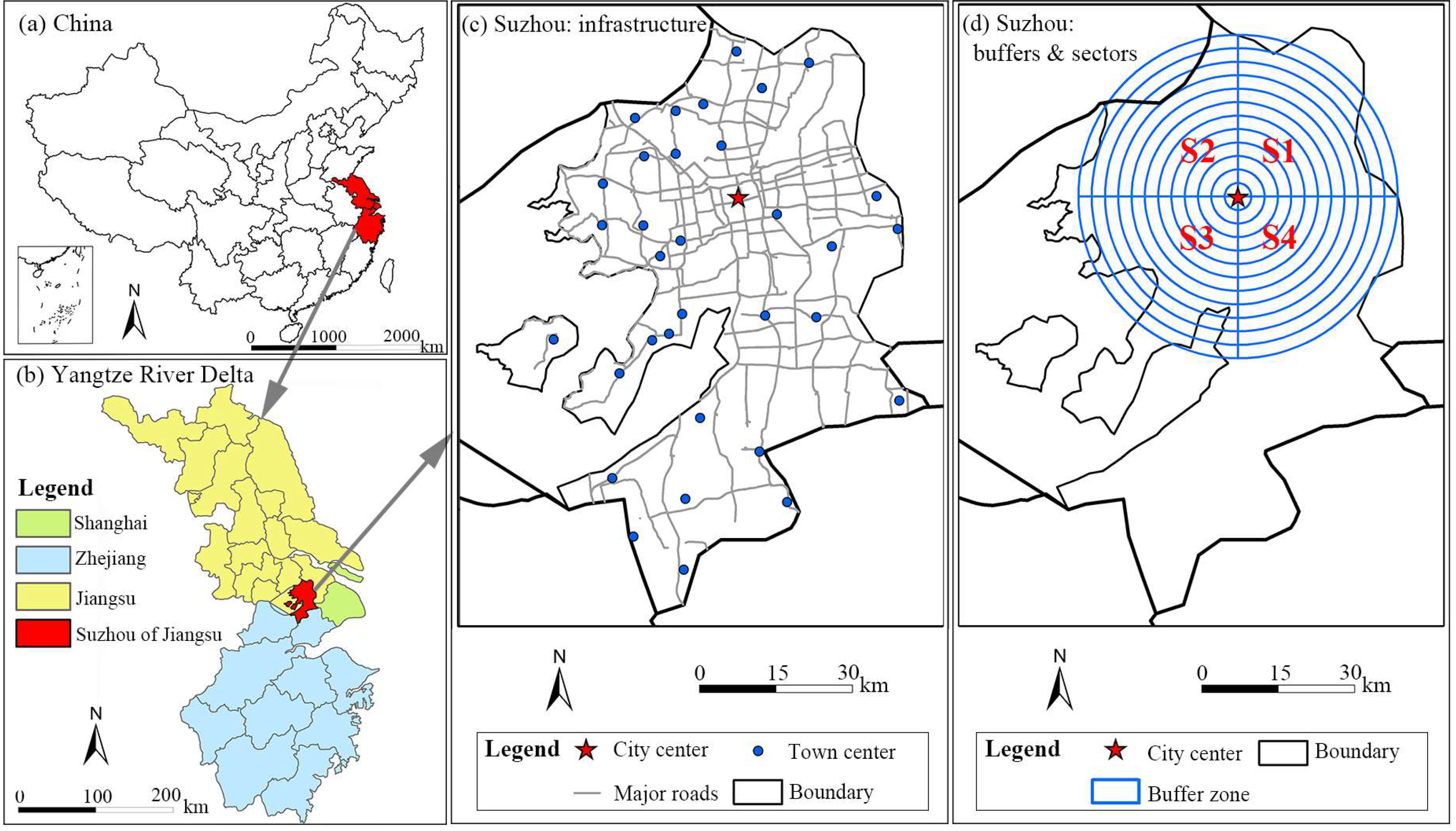

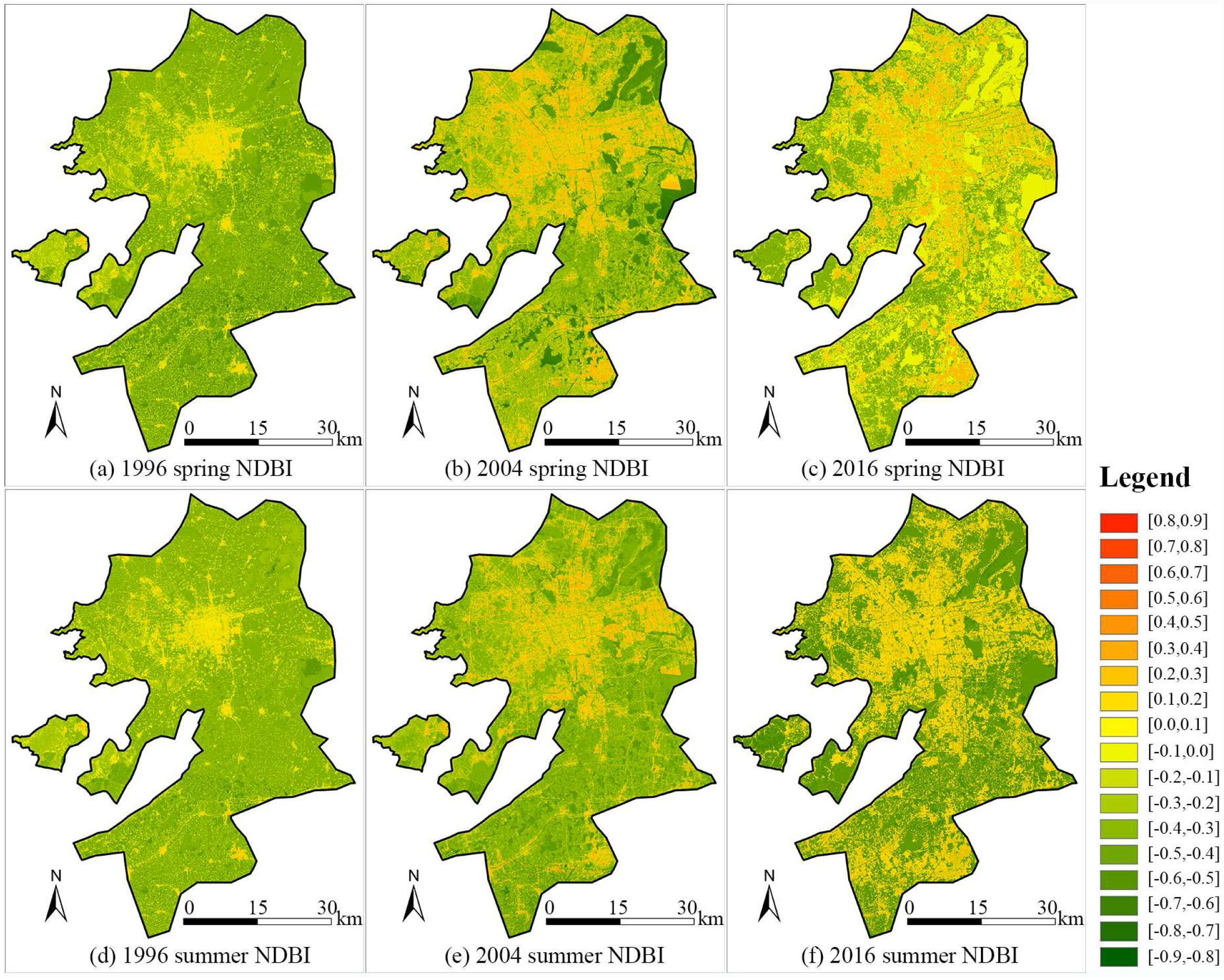
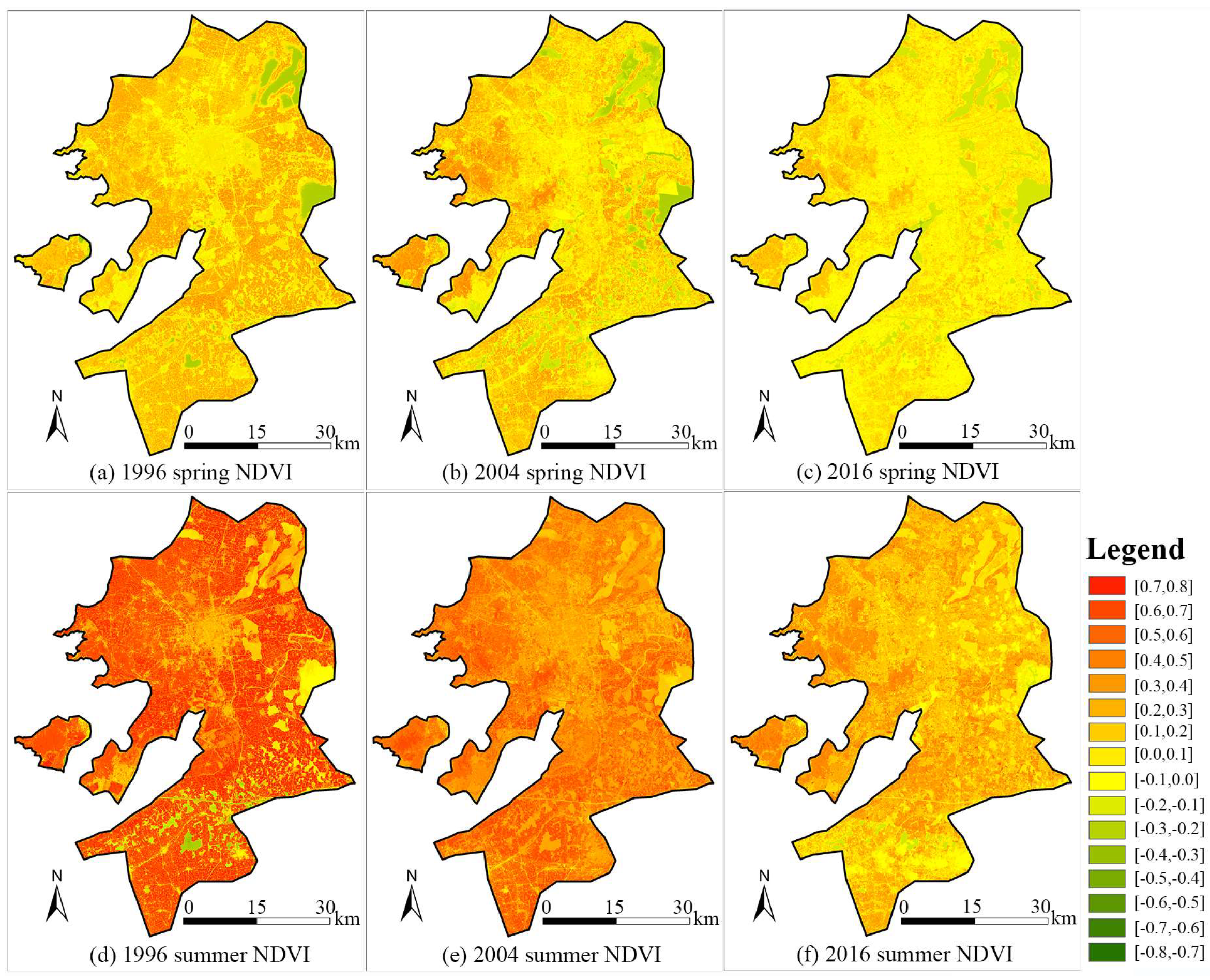
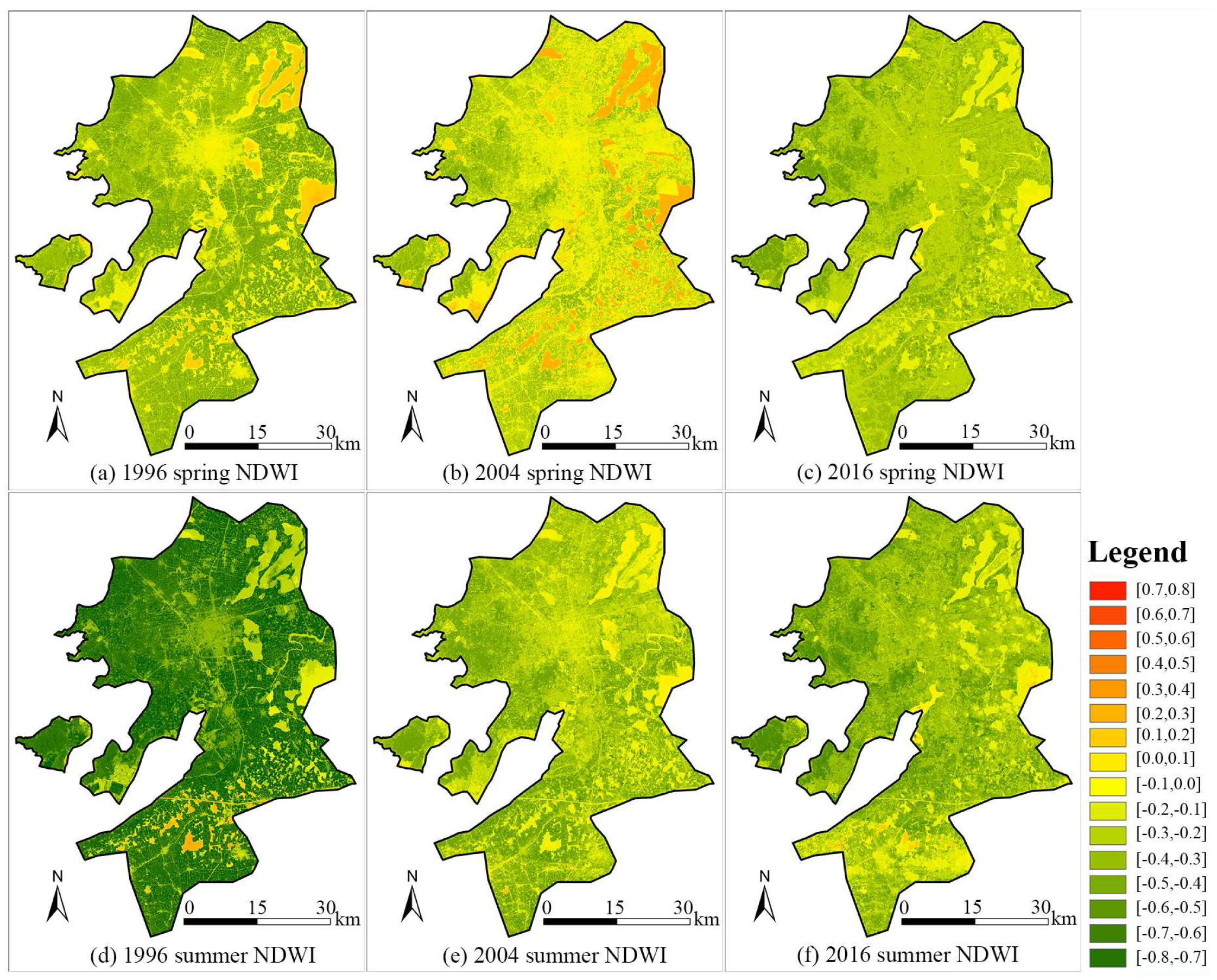
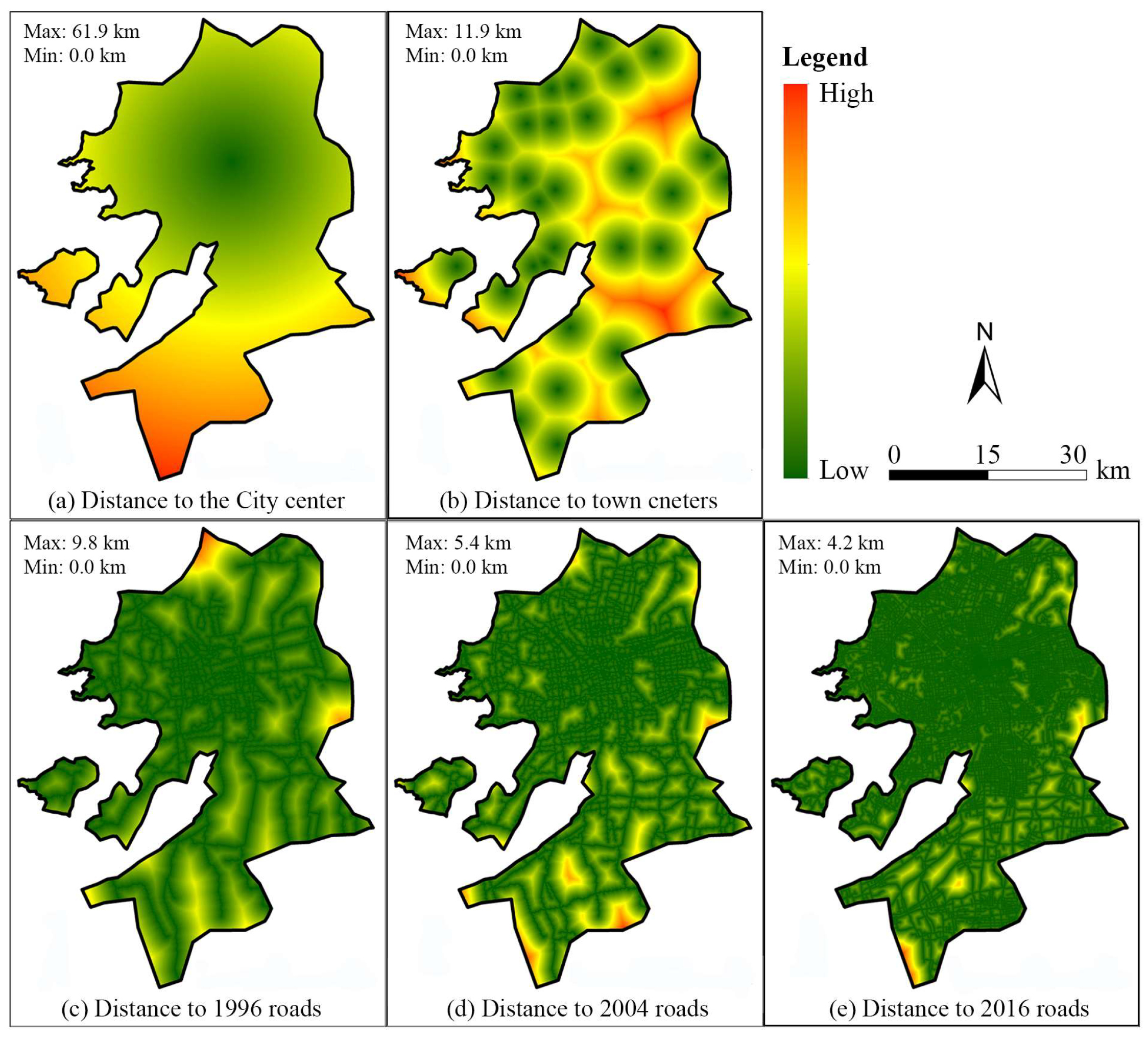
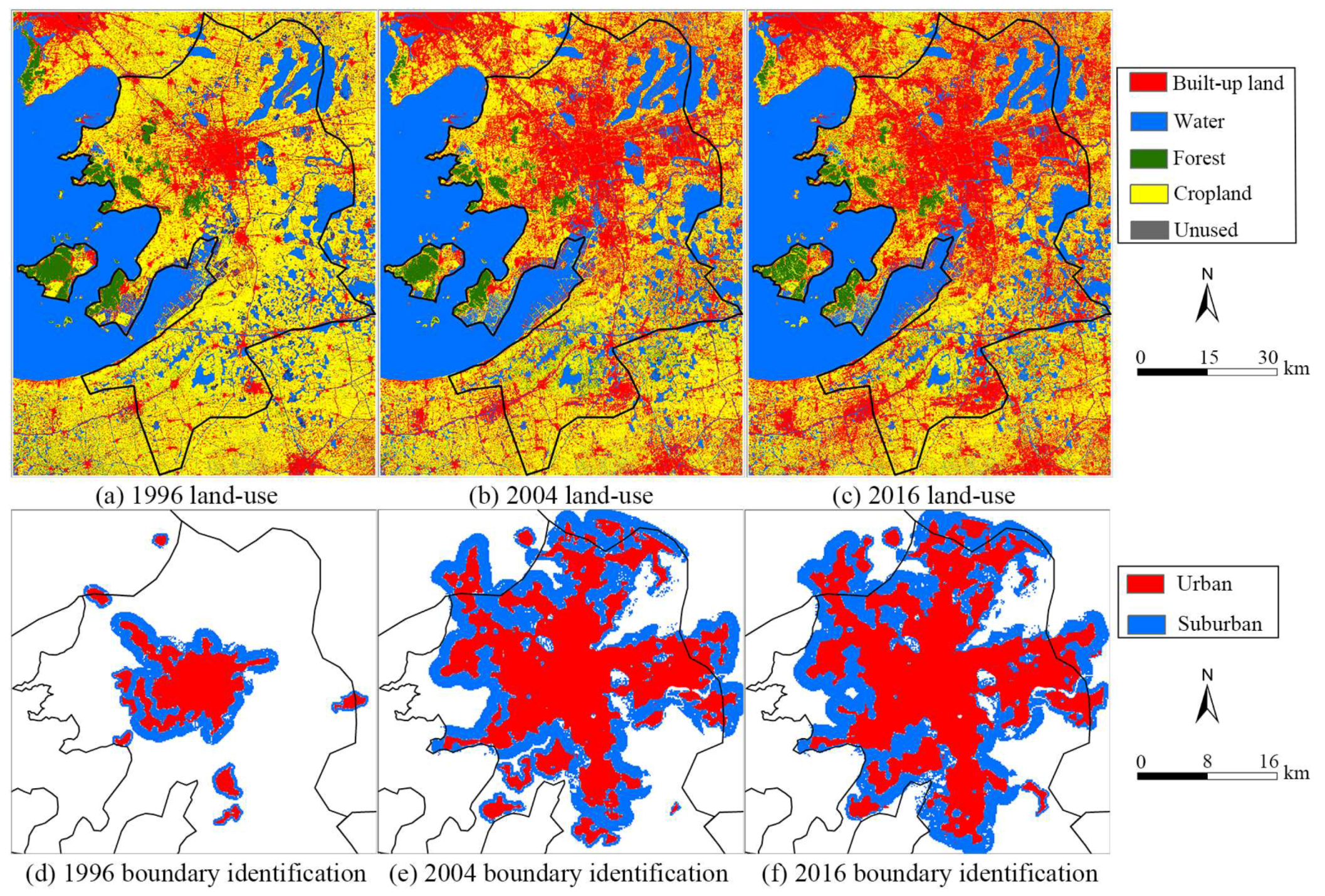
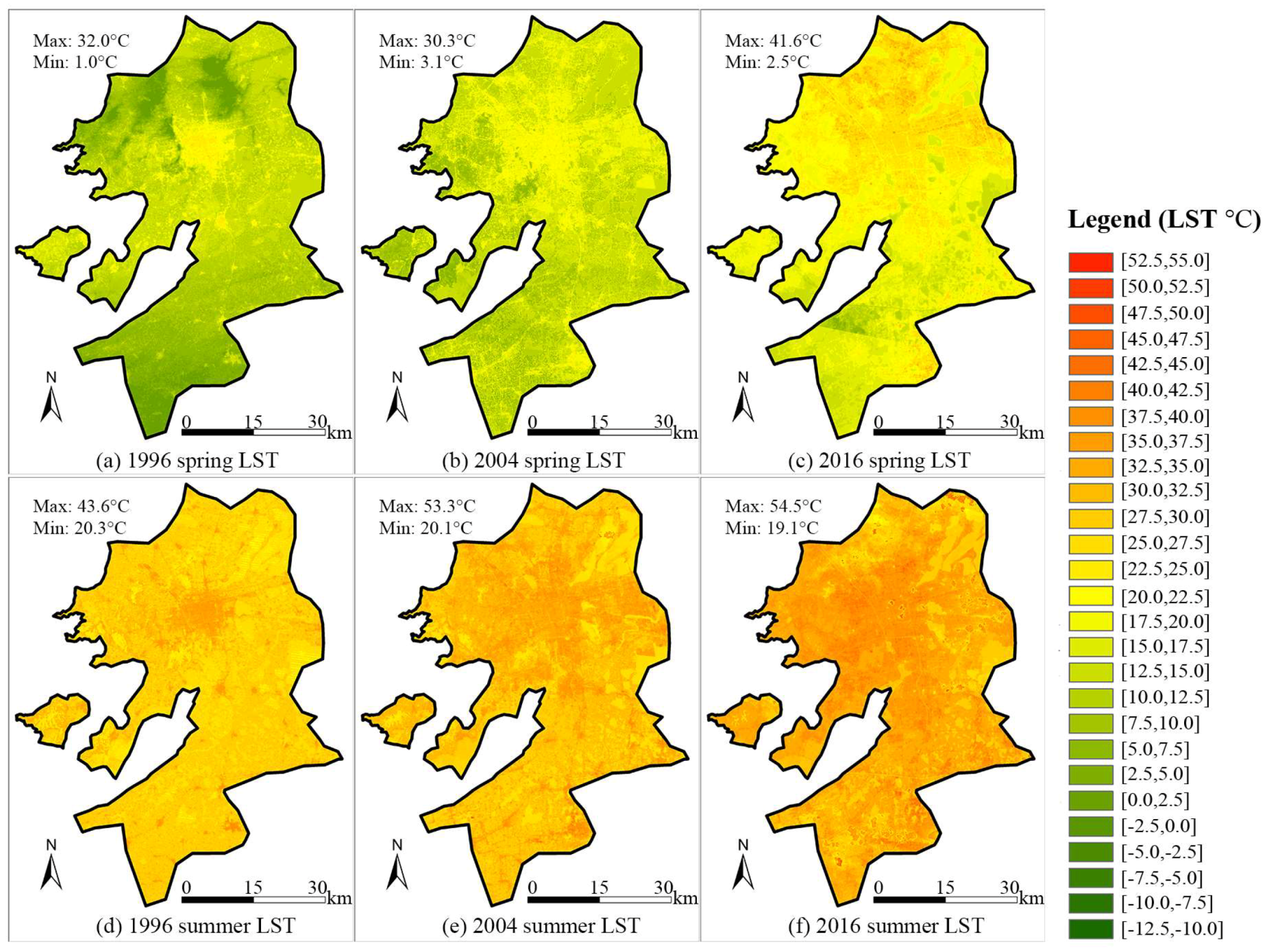
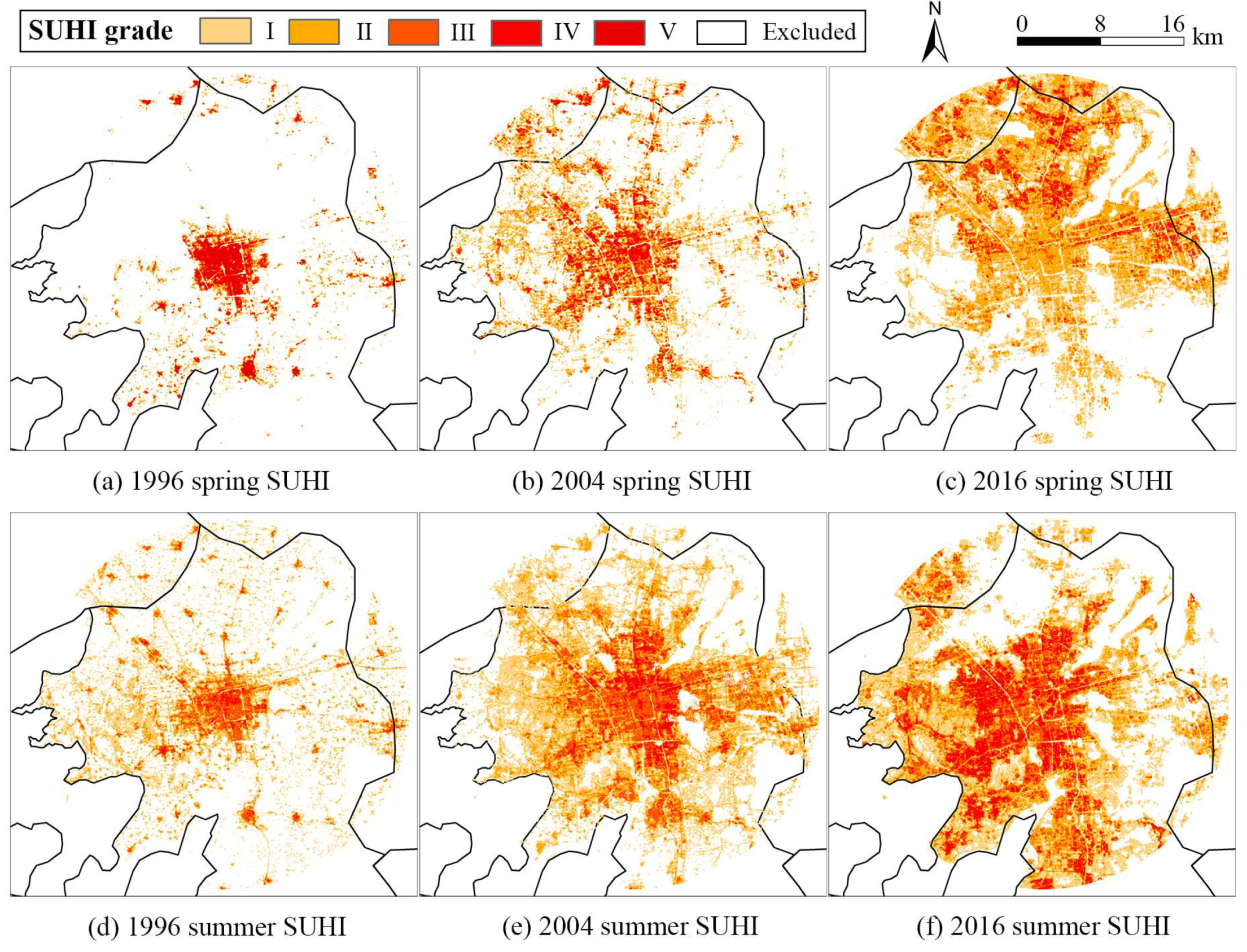
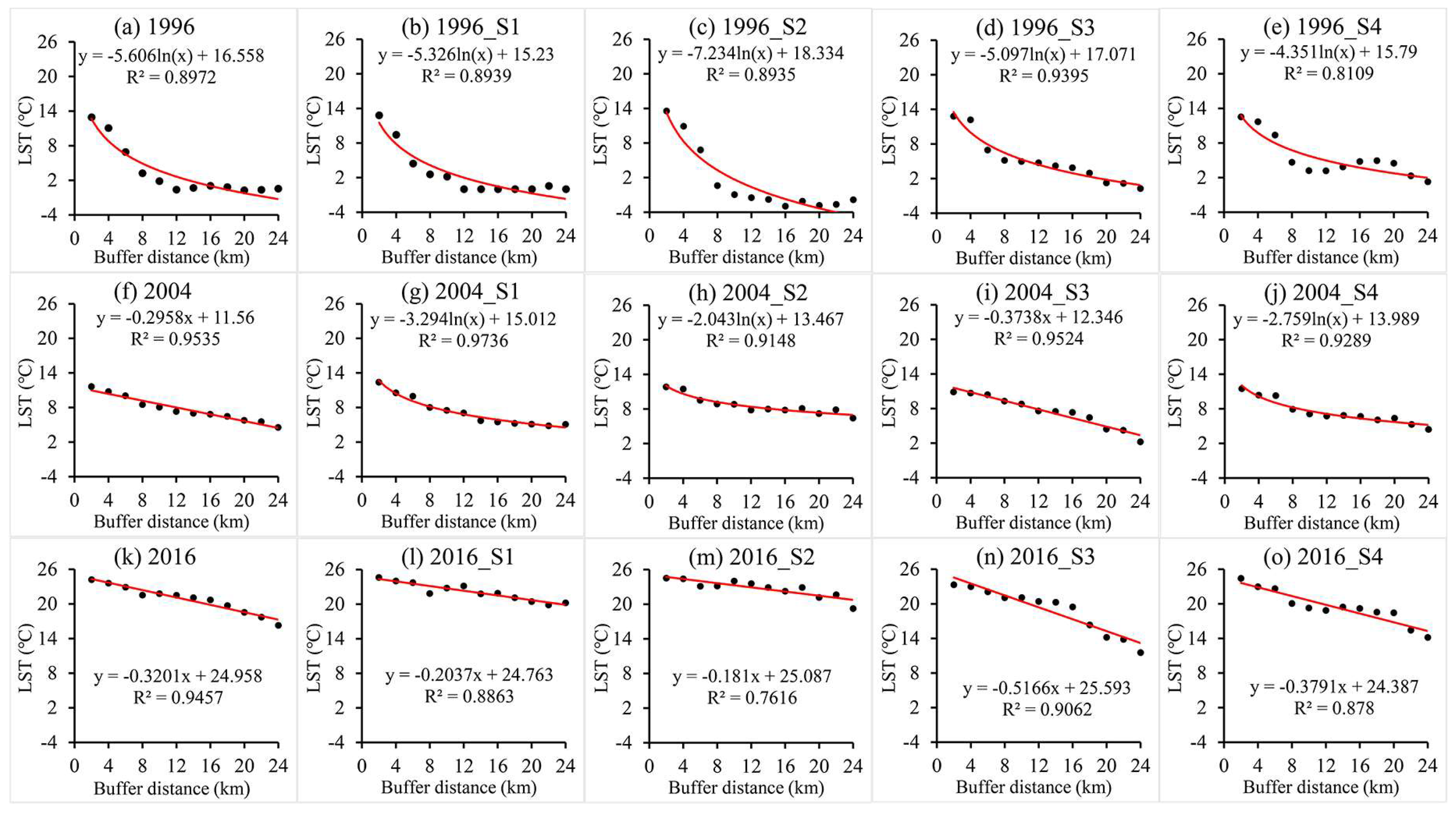
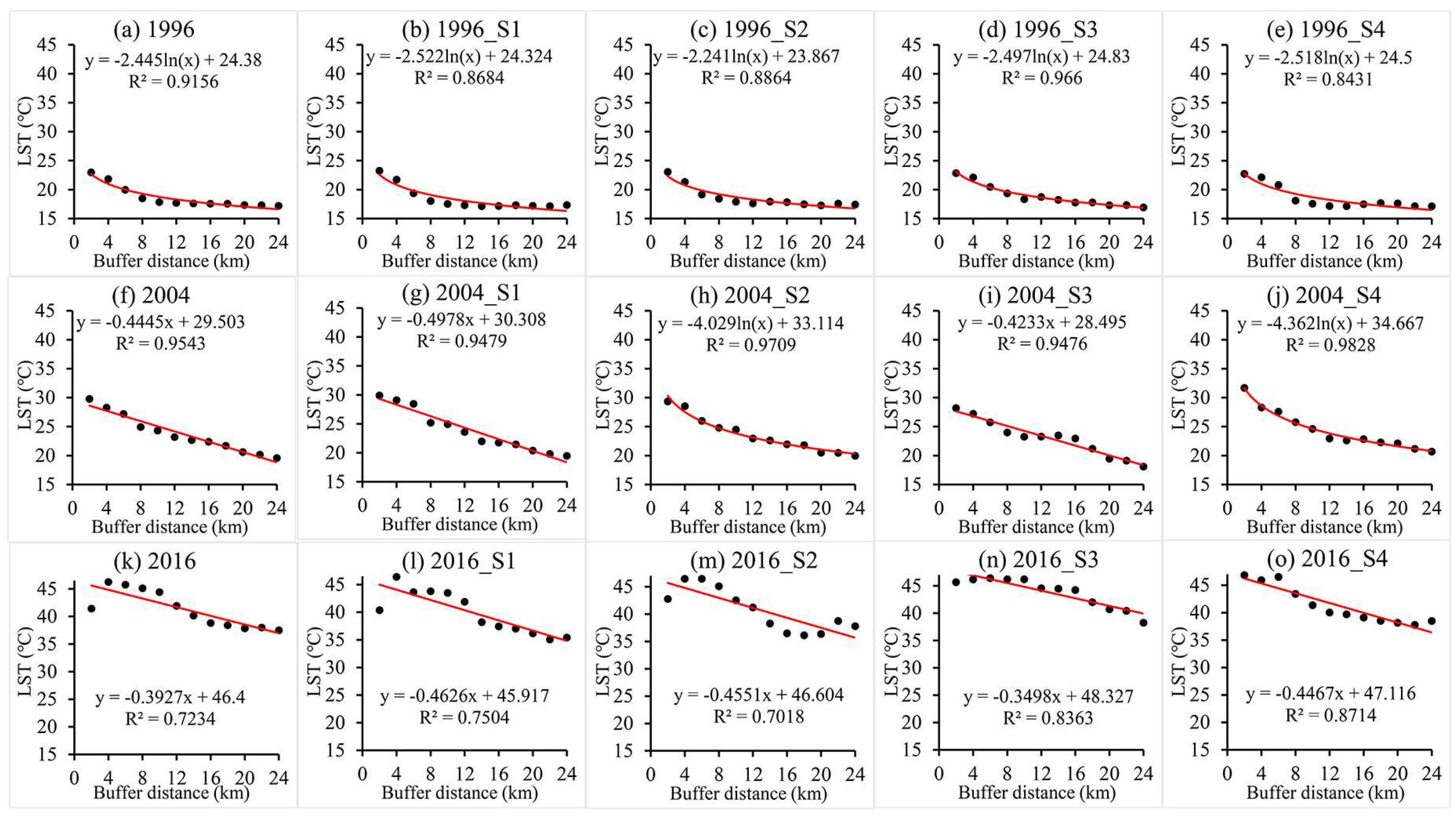
| Satellite | Sensor | Date | Season | Cloud (%) | Usage |
|---|---|---|---|---|---|
| Landsat-5 | TM (30m) | 01 May, 1996 | Spring | 0.0 | Derive LST and land coverage indices |
| Landsat-5 | TM (30m) | 05 Aug, 1996 | Summer | 0.4 | Derive LST, land coverage indices, and land-use pattern |
| Landsat-5 | TM (30m) | 04 Mar, 2004 | Spring* | 0.1 | Derive LST and land coverage indices |
| Landsat-5 | TM (30m) | 23 May, 2004 | Spring* | 0.0 | Derive LST and land coverage indices |
| Landsat-5 | TM (30m) | 26 Jul, 2004 | Summer | 0.0 | Derive LST, land coverage indices and land-use pattern |
| Landsat-8 | OLI (30m) TIRS (30m) | 22 Apr, 2016 | Spring | 0.2 | Derive LST and land coverage indices |
| Landsat-8 | OLI (30m) TIRS (30m) | 27 Jul, 2016 | Summer | 6.4 | Derive LST, land coverage indices and land-use pattern |
| Map | Scale | Feature | Date | Usage |
|---|---|---|---|---|
| Administrative map | 1:1,000,000 | Boundary, city center, and town centers | 2016 | Extract proximity layers |
| Road network map | 1:1,000 | OSM major roads | 1996, 2004, 2016 | Extract proximity layers |
| Level | Temperature Range | Calculation Method |
|---|---|---|
| I | Low temperature | LSTsuburban ≤ LSTori < (LSTsuburban + ∆T) |
| II | Sub-low temperature | (LSTsuburban + ∆T) < LSTori < (LSTsuburban + 2∆T) |
| III | Middle temperature | (LSTsuburban + 2∆T) < LSTori < (LSTsuburban + 3∆T) |
| IV | Sub-high temperature | (LSTsuburban + 3∆T) < LSTori < (LSTsuburban+4∆T) |
| V | High temperature | LSTori ≥ (LSTsuburban + 4∆T) |
| Year | Season (°C) | Min (°C) | Max (°C) | Range (°C) | Mean (°C) | SD |
|---|---|---|---|---|---|---|
| 1996 | Spring | 1.00 | 32.00 | 31.00 | 11.09 | 4.62 |
| Summer | 20.30 | 43.55 | 23.26 | 28.28 | 2.56 | |
| 2004 | Spring | 3.13 | 30.30 | 27.17 | 14.46 | 3.67 |
| Summer | 20.12 | 53.31 | 33.19 | 30.72 | 3.12 | |
| 2016 | Spring | 2.48 | 41.59 | 39.11 | 20.63 | 4.35 |
| Summer | 19.07 | 53.89 | 34.82 | 33.95 | 3.69 |
| Season | 1996 | 2004 | 2016 | ||||||
|---|---|---|---|---|---|---|---|---|---|
| LSTurban | LSTsuburban | ΔT | LSTurban | LSTsuburban | ΔT | LSTurban | LSTsuburban | ΔT | |
| Spring | 4.73 | 3.58 | 1.15 | 7.06 | 5.87 | 1.19 | 22.84 | 20.52 | 2.32 |
| Summer | 19.80 | 17.91 | 1.89 | 25.26 | 21.99 | 3.27 | 41.37 | 37.77 | 3.60 |
| Season | Rank | 1996 | 2004 | 2016 | ||||||
|---|---|---|---|---|---|---|---|---|---|---|
| Driving Factor | ADE (%) | AIC | Driving Factor | ADE (%) | AIC | Driving Factor | ADE (%) | AIC | ||
| Spring | 1 | +D-Y | 51.3 | 6427.71 | +NDVI | 61.9 | 5526.43 | +D-Y | 46. 6 | 6465.20 |
| 2 | +NDBI | 63.7 | 6075.16 | +D-Y | 76.0 | 4967.77 | +NDWI | 67.2 | 5874.43 | |
| 3 | +NDWI | 69.1 | 5881.10 | +NDBI | 82.2 | 4613.61 | +NDBI | 78.4 | 5373.09 | |
| 4 | +D-X | 72.7 | 5752.56 | +NDWI | 83.1 | 4552.96 | +D-X | 81.6 | 5188.70 | |
| 5 | +D-city | 74.6 | 5673.85 | +D-city | 83.7 | 4518.78 | +D-city | 83.2 | 5090.98 | |
| 6 | +NDVI | 75.5 | 5648.72 | +D-town | 84.0 | 4508.96 | +D-road | 84.3 | 5021.60 | |
| 7 | +D-road | 75.8 | 5637.41 | +D-X | 84.3 | 4494.06 | +D-town | 85.0 | 4981.46 | |
| 8 | +D-town* | 75.8 | 5638.24 | +D-road | 84.3 | 4495.68 | +NDVI | 85.4 | 4952.90 | |
| Summer | 1 | +NDBI | 42.3 | 5110.99 | +NDBI | 56.3 | 5315.95 | +NDWI | 18.3 | 6566.45 |
| 2 | +NDWI | 50.3 | 4943.03 | +NDWI | 59.0 | 5247.30 | +NDVI | 36.5 | 6263.40 | |
| 3 | +D-city | 53.7 | 4869.08 | +NDVI | 62.9 | 5139.85 | +D-Y | 45.0 | 6101.55 | |
| 4 | +NDVI | 55.8 | 4813.21 | +D-X | 64.1 | 5112.77 | +D-X | 47.9 | 6045.81 | |
| 5 | +D-Y | 56.4 | 4807.30 | +D-city | 64.9 | 5091.08 | +NDBI | 50.3 | 5996.70 | |
| 6 | +D-X | 57.4 | 4787.89 | +D-Y | 65.5 | 5079.15 | +D-town | 51.6 | 5973.33 | |
| 7 | +D-road | 58.1 | 4776.39 | +D-road | 65.8 | 5070.68 | +D-road | 52.9 | 5945.46 | |
| 8 | +D-town* | 58.2 | 4775.86 | +D-town | 65.9 | 5058.02 | +D-city | 54.2 | 5931.15 | |
| Driving Factor | Year | Interval and Trend | Effect | |||
|---|---|---|---|---|---|---|
| Interval | Trend | Interval | Trend | |||
| NDBI | 1996 | > −0.4* | ↗ | Monotonous | ||
| 2004 | > −0.3* | ↗ | Monotonous | |||
| 2016 | −0.3*–0.0 | ↗↗ | > 0.0 | ↗ | Piecewise | |
| NDWI | 1996 | −0.4*–0.0 | ↗ | > 0.2 | ↘ | Piecewise |
| 2004 | −0.3*–0.1 | ↘ | > 0.1 | ↘↘ | Piecewise | |
| 2016 | > −0.4* | ↘ | Monotonous | |||
| NDVI | 1996 | > −0.23* | ↘ | Piecewise | ||
| 2004 | > −0.3* | ↘ | Monotonous | |||
| 2016 | > 0.0 | ↘ | Monotonous | |||
| D-road | 1996 | > 0 km | ↘ | Monotonous | ||
| 2004 | > 0 km | ↘ | Monotonous | |||
| 2016 | > 0 km | ↘ | Monotonous | |||
| D-city | 1996 | 0–10 km | ↘ | > 10 km | ↗ | Piecewise |
| 2004 | 0–10 km | ↘ | > 10 km | ↗ | Piecewise | |
| 2016 | 0–25 km | ↘ | > 25 km | ↗ | Piecewise | |
| D-town | 1996 | Not significant | ||||
| 2004 | > 0 km | ↗ | Monotonous | |||
| 2016 | 0–2 km | ↘ | > 2 km | ↗ | Monotonous | |
| Driving Factor | Year | Interval and Trend | Effect | |||||
|---|---|---|---|---|---|---|---|---|
| Interval | Trend | Interval | Trend | Interval | Trend | |||
| NDBI | 1996 | > −0.60* | ↗ | Monotonous | ||||
| 2004 | −0.3–−0.2 | ↘ | −0.2–−0.15 | ↗↗ | > −0.15 | ↗ | Piecewise | |
| 2016 | > −0.33* | ↗ | Monotonous | |||||
| NDWI | 1996 | > −0.70* | ↘ | Monotonous | ||||
| 2004 | > −0.43* | ↘ | Monotonous | |||||
| 2016 | > −0.52* | ↘ | Monotonous | |||||
| NDVI | 1996 | > −0.25* | ↘ | Monotonous | ||||
| 2004 | 0–0.1 | ↗ | > 0.1 | ↘ | Piecewise | |||
| 2016 | > −0.1* | ↘ | Monotonous | |||||
| D−road | 1996 | > 0 km | ↘ | Monotonous | ||||
| 2004 | > 0 km | ↘ | Monotonous | |||||
| 2016 | > 0 km | ↘ | Monotonous | |||||
| D−city | 1996 | 0–10 km | ↘ | > 10 km | ↗ | Piecewise | ||
| 2004 | 0–30 km | ↘ | > 30 km | ↗ | Piecewise | |||
| 2016 | 0–40 km | ↘ | > 40 km | ↗ | Piecewise | |||
| D−town | 1996 | Not significant | ||||||
| 2004 | > 0 km | ↗ | Monotonous | |||||
| 2016 | 0–3 km | ↘ | > 3 km | ↗ | Piecewise | |||
© 2019 by the authors. Licensee MDPI, Basel, Switzerland. This article is an open access article distributed under the terms and conditions of the Creative Commons Attribution (CC BY) license (http://creativecommons.org/licenses/by/4.0/).
Share and Cite
Feng, Y.; Gao, C.; Tong, X.; Chen, S.; Lei, Z.; Wang, J. Spatial Patterns of Land Surface Temperature and Their Influencing Factors: A Case Study in Suzhou, China. Remote Sens. 2019, 11, 182. https://doi.org/10.3390/rs11020182
Feng Y, Gao C, Tong X, Chen S, Lei Z, Wang J. Spatial Patterns of Land Surface Temperature and Their Influencing Factors: A Case Study in Suzhou, China. Remote Sensing. 2019; 11(2):182. https://doi.org/10.3390/rs11020182
Chicago/Turabian StyleFeng, Yongjiu, Chen Gao, Xiaohua Tong, Shurui Chen, Zhenkun Lei, and Jiafeng Wang. 2019. "Spatial Patterns of Land Surface Temperature and Their Influencing Factors: A Case Study in Suzhou, China" Remote Sensing 11, no. 2: 182. https://doi.org/10.3390/rs11020182
APA StyleFeng, Y., Gao, C., Tong, X., Chen, S., Lei, Z., & Wang, J. (2019). Spatial Patterns of Land Surface Temperature and Their Influencing Factors: A Case Study in Suzhou, China. Remote Sensing, 11(2), 182. https://doi.org/10.3390/rs11020182




